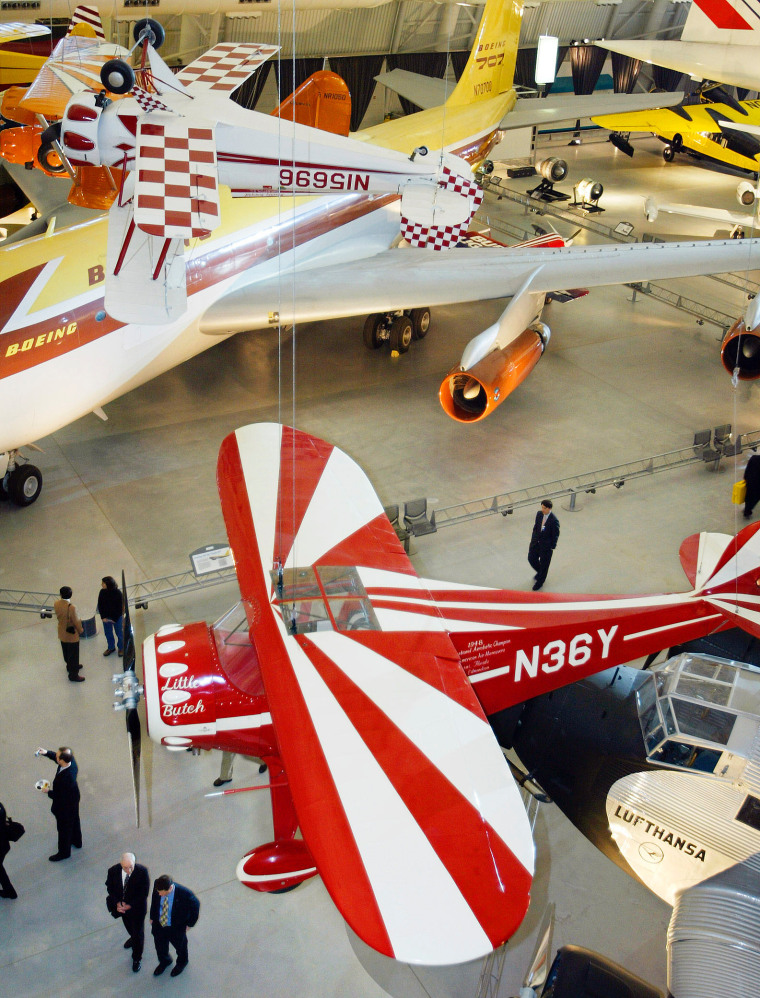When you’ve circled Earth and stood on the moon, it takes a lot to be impressed. But John Glenn and Neil Armstrong gaped along with 2,000 others Thursday at the dozens of aviation marvels in a new second home for the National Air and Space Museum.
The huge museum, 28 miles (45 kilometers) west of the original’s home on the National Mall, opens Monday and features everything from gliders to a sleek SR-71 Blackbird spy plane, its maximum speed still kept secret by the government.
Visitors gasped at the impressive collection: the Enola Gay, the Enterprise space shuttle, the Concorde, Amelia Earhart’s flight suit and various rockets, missiles, satellites, fighters and jetliners.
Vice President Dick Cheney, who presided over the dedication, called it “a monument to the great achievements of flight and to the even greater possibilities of the future.”
Applause and cheers
There were rounds of applause and cheers for some aviation pioneers. Armstrong was the first man to walk on the moon. Glenn was the first American to orbit Earth. Scott Crossfield was the first to fly at Mach 2 and Mach 3. Burt Rutan designed Voyager, which flew nonstop around the world in 1986.
Paul Tibbetts, who commanded the Enola Gay, stood in front of the restored aircraft and chatted about his role aboard the plane that dropped an atomic bomb on Hiroshima, Japan, in 1945.
Museum officials avoided the controversy that grounded a 1995 exhibit of the Enola Gay because it discussed the effects of the bomb dropped by the B-29 bomber. Japanese survivors say they want the exhibit to focus more on the damage of the atom bomb.
For Gale Fitzwater of Fairfax County, Va., the 82 restored aircraft and 61 large space artifacts reflect the amazing technological change that have occurred in her mother’s 94-year-lifetime.
“It’s just unbelievable,” she said. Added her husband, Mike, “This is just the single most amazing thing I’ve seen.”
For actor and pilot John Travolta, the most moving moment of the ceremony came when the space station astronauts, televised from space via satellite, counted down for a replica Wright Flyer to start gliding from the 10-story ceiling onto the stage.
“I started to cry,” said Travolta, who had introduced the pioneers of flight. “It was the most advanced moment in aviation with the first moment in a heartbeat.”
Millions to visit
It is estimated that 3 million people will visit the museum, which is next to Dulles International Airport, in its first year. The original Air and Space Museum, which will remain open, is the most visited museum in the world, averaging 9 million guests a year. Both are free, though parking at the new facility costs $12.
The building in downtown Washington displays only about 10 percent of the museum’s priceless collection of aircraft and large space artifacts. About 10 percent is on loan to museums around the world. The rest has been kept at the museum’s restoration and storage facility in Suitland, Md., and in hangars at Dulles and elsewhere.
The newest addition to the Smithsonian Institution is named for Steven F. Udvar-Hazy, a Hungarian immigrant who made a fortune in aircraft leasing. Udvar-Hazy donated $65 million for the project, which is estimated to cost $311 million when complete. It is the Smithsonian’s largest-ever donation.
Elevated walkways that rise 50 feet (14 meters) allow people to get close to biplanes, ultralights, gliders and stunt planes, suspended as if in their typical flight maneuvers.
Outside the huge hangar, visitors can watch planes taking off and landing from Dulles in a 164-foot-high (50-meter-high) observation tower, which has equipment like that used in an airport control tower.
The facility is not completely finished. Plans call for another 118 aircraft to be restored in the next four years, the opening of a space hangar and construction of a renovation and archives storage building.
